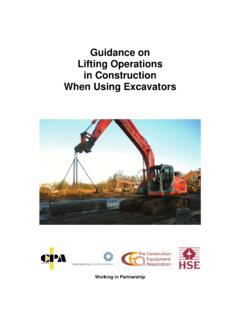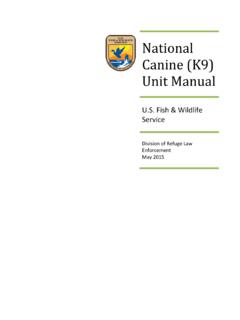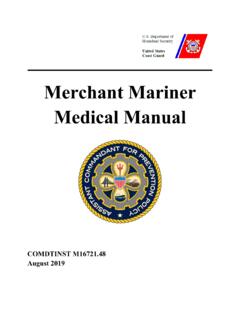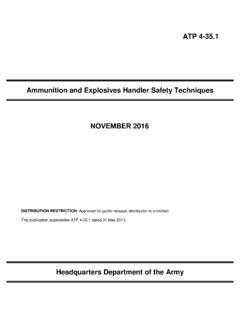Transcription of Safe Use of Telehandlers in Construction Second Revision
1 Safe Use of Telehandlers in Construction Second Revision Safe Use of Telehandlers in Construction 2 March 2015 Safe Use of Telehandlers In Construction Strategic Forum for Construction Good Practice Guide Working in Partnership Reference No. CPA 1101 First Published: February 2011 First Revision : June 2013 Second Revision : March 2015 Published by: Construction Plant-hire Association 27/28 Newbury St London EC1A 7HU Telephone: 020 7796 3366 Email: CPA Copyright 2011, 2013 & 2015 Safe Use of Telehandlers in Construction 3 March 2015 Contents Page Foreword .. 4 1. Introduction and 5 2. Definitions .. 10 3. Planning .. 15 4. Telehandler Principles .. 18 5. Types of Telehandler and Attachments .. 31 6. Selection of Telehandlers and Attachments .. 34 7. Provision of Information.
2 36 8. Planning, Supervisory and Operating Personnel .. 38 9. Familiarisation .. 44 10. Safe Use of Telehandlers .. 45 11. Review and Monitoring of the Safe Use of 60 12. Maintenance and Inspection .. 65 13. Thorough Examination .. 71 Annex A Example Risk Assessment and Method Statement for Non -suspended Loads .. 72 Annex B Planning of the Lifting of Suspended Loads .. 74 Annex C Example of a Method Statement for Lifting Suspended Loads with a 82 Annex D Example of a Lifting Schedule .. 90 Annex E Example of a Checklist for 91 Annex F Example of Daily (pre-use) Checks .. 92 Annex G Key Points for Telehandler Operators .. 95 Annex H Key Points for Supervisors of Telehandler Operators .. 96 Annex I Key Points for Telehandler Operators - Lifting and Travelling with Suspended Loads .. 97 Annex J Key Points for Supervisors of Telehandler Operators - Lifting and Travelling with Suspended Loads.
3 98 Annex K Further Information and Guidance .. 99 Annex L Topic Index .. 102 Annex M Working Group Membership .. 103 NOTE: Whilst every care has been taken to ensure the accuracy of the material contained within this booklet, no liability is accepted by the Construction Plant-hire Association in respect of the information given. No material from this booklet may be reproduced in any shape or form without the permission of the Construction Plant-hire Association. Safe Use of Telehandlers in Construction 4 March 2015 Foreword Telehandlers are one of the most versatile pieces of Construction site equipment, making a significant contribution to the efficient delivery of the Construction process. The development of Telehandlers in both capacity and reach to the stage where they are able to carry out many of the tasks traditionally undertaken by mobile and tower cranes introduces new challenges.
4 Unfortunately the very versatility that makes them so useful also provides scope for unsafe use. This has led to a significant number of serious accidents, tragically including some fatalities. Not only do these accidents have a terrible cost in terms of human suffering, they also have a significant financial cost for all concerned. Consequently there is a very strong business case for improving safety performance. As with all lifting equipment, safe operation of Telehandlers depends on a number of factors including the selection and maintenance of the telehandler, the planning and supervision of its use, and the competence of the operator. If any of these are deficient, the risk of a serious accident increases significantly and it is therefore essential that site managers ensure that all telehandler operations are planned, supervised and carried out safely by competent people.
5 This guidance has been developed by a working group representing all parts of the industry. It provides clarity on the safe use of Telehandlers and will help telehandler suppliers and users improve health and safety standards. The guidance addresses planning for safe use, roles and responsibilities, inspection, maintenance and thorough examination and training . The advice in this document is straightforward, comprehensive and easy to adopt. This guidance may go further than the minimum you need to do to comply with the law. I thank those who have been involved in its preparation and commend the guidance to anyone who owns, supplies or controls the operation of Telehandlers . Please read the publication and turn the advice into action. Heather Bryant HM Chief Inspector of Construction Chair of the Health and Safety Executive s Construction Industry Advisory Committee (CONIAC).
6 Safe Use of Telehandlers in Construction 5 March 2015 Introduction and Summary Telehandlers (also known as Rough Terrain Telescopic handlers or Variable Reach Trucks) make a valuable contribution to the Construction process by enabling materials to be unloaded from delivery vehicles, transported around Construction sites and placed at height (reach). They are versatile machines which can be fitted with a wide range of attachments such as buckets, skips, work platforms and crane jibs. Unfortunately there have been a significant number of accidents involving the use of Telehandlers , which have tragically included a number of fatalities. This document is intended to provide guidance on the management and supervision of the use of Telehandlers on Construction sites including planning, equipment selection, selection and training of personnel, provision of information, familiarisation, safe use, maintenance, inspection and thorough examination, together with monitoring of the whole process.
7 It is essential that in managing the use of Telehandlers , adequate attention is paid to all aspects of the process selection of the correct equipment for the application, planning its use by competent people, monitoring the activity and rectification of issues; if any one aspect is ignored the probability of an incident will increase significantly, putting both the machine operator and people in the vicinity at risk. The document structure starts with principles and moves on to specific requirements and information. This inevitably leads to information on certain topics, such as visibility, appearing in more than one section and is a deliberate strategy to ensure that readers who dip into the document are given adequate information in one place. A topic index had been provided at Annex H to facilitate easy navigation of the document.
8 The advice given in this document is based on the current state of the art of telehandler design. As new designs are developed, this document will be updated to reflect any such changes to the state of the art. Whilst the document is aimed specifically at the Construction industry, its guidance applies to other sectors of industry where Telehandlers are used. Where local rules are more onerous than those set out in this document, they take precedence. The following parts of Section are a summary of the main body of the document, giving a brief outline of the items covered. Sections 2 to 13 and the Annexes should be consulted for detailed guidance Planning All operations on Construction sites should be planned to ensure that they are carried out safely and that all foreseeable risks have been taken into account. Poor planning is one of the major causes of accidents arising from the use of Telehandlers and the responsibility for planning tasks lies with the employer who is undertaking that task.
9 The employer should ensure that they identify a person who is competent to undertake the planning and give them that duty. The planning process should identify the task to be undertaken, identify the hazards associated with that task, carry out a risk assessment, identify control measures, develop the method to be used (including the selection of appropriate equipment), record the planning in a method statement, communicate the plan to all those involved in the task and review the plan before the job starts. Where a telehandler is to be used as a crane for lifting suspended loads and travelling with those loads, additional planning is required by a person competent to undertake the task, the Competent Person (often referred to as the Appointed Person), taking account of the additional hazards associated with these activities. Details of this process are given in Annex B.
10 Additional planning is also required for other non standard lifting operations such as unusual loads, or circumstances, loads with large wind areas, use of integrated work platforms, use of special attachments, use in confined spaces, and use in tight areas where contact with other structures could be hazardous. As Telehandlers are not primarily designed for lifting suspended loads the first step should be to ensure that a telehandler is the most suitable equipment for carrying out the task. Safe Use of Telehandlers in Construction 6 March 2015 Unlike a mobile crane, tower crane or lorry loader a non rotating telehandler cannot lift a load over a point without the operator simultaneously raising and extending the boom to keep the suspension point stationary on the horizontal plane. Similarly if the load is to be moved to either side of the telehandler centreline the whole machine has to be moved on its wheels, rather than using the slew motion of a crane.




